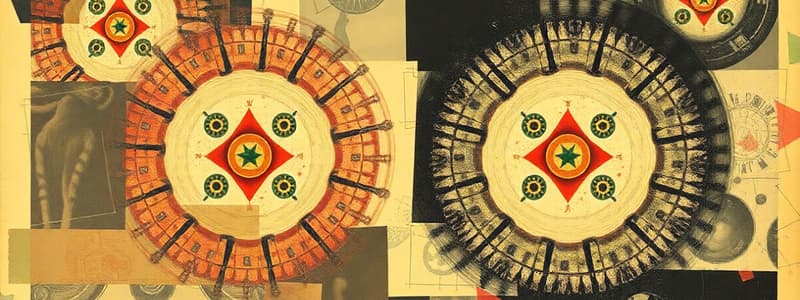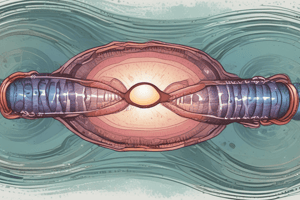Podcast
Questions and Answers
What is the primary function of meiosis?
What is the primary function of meiosis?
Meiosis is a type of cell division that produces gametes (sex cells), which have half the number of chromosomes as the parent cell.
What are homologous chromosomes?
What are homologous chromosomes?
Homologous chromosomes are pairs of chromosomes that have the same genes in the same locations but may have different versions of those genes.
What happens during the process of recombination (crossing over)?
What happens during the process of recombination (crossing over)?
During recombination, homologous chromosomes exchange genetic material, leading to the shuffling of alleles.
What is the role of the synaptonemal complex during meiosis?
What is the role of the synaptonemal complex during meiosis?
What is the difference between sister chromatids and homologous chromosomes?
What is the difference between sister chromatids and homologous chromosomes?
How do chromosomes align during metaphase I of meiosis?
How do chromosomes align during metaphase I of meiosis?
What is the significance of the reductional division in meiosis?
What is the significance of the reductional division in meiosis?
What are the four phases of meiosis I?
What are the four phases of meiosis I?
What are chiasmata?
What are chiasmata?
What is the significance of the equational division in meiosis II?
What is the significance of the equational division in meiosis II?
How many cells are produced at the end of meiosis?
How many cells are produced at the end of meiosis?
Flashcards
Meiosis (eukaryotes)
Meiosis (eukaryotes)
A type of cell division that reduces the number of chromosomes by half, producing genetically diverse haploid gametes.
Meiosis in males
Meiosis in males
Continuous after puberty, producing 4 sperm cells.
Meiosis in females
Meiosis in females
Begins in the fetus, ending with fertilization; produces 1 oocyte (egg) and 2 polar bodies.
Homologous chromosomes
Homologous chromosomes
Signup and view all the flashcards
Replicated chromosomes
Replicated chromosomes
Signup and view all the flashcards
Sister chromatids
Sister chromatids
Signup and view all the flashcards
Synapsis
Synapsis
Signup and view all the flashcards
Crossing over
Crossing over
Signup and view all the flashcards
Chiasmata
Chiasmata
Signup and view all the flashcards
Meiosis I
Meiosis I
Signup and view all the flashcards
Meiosis II
Meiosis II
Signup and view all the flashcards
Reductive division
Reductive division
Signup and view all the flashcards
Haploid gametes
Haploid gametes
Signup and view all the flashcards
Recombination (crossing over)
Recombination (crossing over)
Signup and view all the flashcards
Random alignment
Random alignment
Signup and view all the flashcards
Spindle fibers
Spindle fibers
Signup and view all the flashcards
Metaphase plate
Metaphase plate
Signup and view all the flashcards
Non-crossover events
Non-crossover events
Signup and view all the flashcards
crossover event
crossover event
Signup and view all the flashcards
Synaptonemal complex
Synaptonemal complex
Signup and view all the flashcards
Prophase I
Prophase I
Signup and view all the flashcards
Cytoplasm division
Cytoplasm division
Signup and view all the flashcards
4 sperm cells
4 sperm cells
Signup and view all the flashcards
1 oocyte
1 oocyte
Signup and view all the flashcards
Study Notes
Time Management vs. Focus
- Time is not a problem, focus is.
- Images of clocks show a difference between sufficient time and lack of focus.
Meiosis in Eukaryotes
- Meiosis is a reproductive process for eukaryotic organisms.
Meiosis in Mammals
- Males: Produce 4 sperm cells continuously after puberty.
- Females: Begin meiosis in the fetus, completing it with fertilization.
- Produces 1 oocyte and 2 polar bodies.
Meiosis
- A reductive division to produce separate genetically distinct haploid gametes.
Chromosome Terminology
- Homologous chromosomes: A pair of chromosomes in a diploid organism that have:
- Almost identical DNA sequences.
- Same genes in the same location (locus).
- Same size.
- Centromere in the same location.
- Unreplicated chromosomes: A single pair of chromosomes.
- 2 chromosomes.
- 2 double stranded DNA molecules (1 per chromosome).
- Replicated chromosomes: A copied pair of chromosomes
- 2 replicated chromosomes.
- 4 double stranded DNA molecules.
- Each is made of 2 sister chromatids.
Structure of the Synaptonemal Complex
- Diagram showing different stages (Leptotene, Zygotene, Pachytene, Diplotene) of the synaptonemal complex.
- Contains components such as Axial Elements, Transverse Elements, and Central Element.
Early Prophase I
- Chromosomes condense, synapse, and recombination begins.
- Replicated chromatin is packed onto the axial elements
- Recombination hotspots are found and DSBs occur
- Telomeres anchor to the nuclear envelope for homologous pairing, aligning axes together.
Prophase I: Homologues Pair
- Homologous chromosomes pair.
- Synapsis proceeds along the length of the chromosome.
- DSB repairs allow recombination.
- Most breaks=non-crossover events
- Minority=crossover events.
- Transverse filaments(green), bind the central element (red) of homologous chromosomes.
Prophase I: Fully Synapse
- Chromosomes are fully synapsed.
- Recombination is finalized with DSB repairs.
- Proteins are involved in DSBs and repair.
Prophase I: Desynapse
- Synaptonemal complex disassembled.
- Homologous chromosomes held together by chiasmata.
Meiosis I: Reductional Division
-
Prophase I: Replication chromosomes condense, synapse, crossing over, nuclear envelope breaks down.
-
Metaphase I: Homologous pairs are aligned by spindle fibers.
-
Anaphase I: Homologues separate to opposite poles.
-
Telophase I & Cytokinesis: Cytoplasm divides, may reform nuclear envelopes and chromosomes decondense.
-
C value: The number of chromosomes, and the number of DNA molecules.
Meiosis II: Equational Division
- Prophase II: Chromosomes condense, new spindle forms. Nuclear envelope breaks down.
- Metaphase II: Replicated chromosomes align at the metaphase plate.
- Anaphase II: Sister chromatids separate to opposite poles.
- Telophase II, Cytokinesis: Chromosomes arrive at the poles, nuclear envelope forms, and cytoplasm divides.
Meiosis: Unique Cells
-
Product = 4 cells
-
Chromosome number is halved (2n → n)
-
Cells are genetically different
-
Recombination: Exchange of DNA between non-sister chromatids.
-
Random alignment (Metaphase I and II): Allows assortment and shuffling of chromosomes.
-
Random distribution: Random placement of maternal and paternal chromosomes.
Random Alignment on Metaphase Plate
- Diagram showing different possible combinations from random alignment in metaphase I.
- 8 possible combinations in gametes.
Cell Cycle (Eukaryotes)
- Diagram showing stages in a circle.
- Shows mitosis (Prophase, Metaphase, Anaphase, Telophase, Cytokinesis)
- Includes DNA replication in the Interphase Stages: G1, S, G2, and G0.
Synaptonemal Complex- Detailed View
- Diagram illustrating the complex structure and components of the synaptonemal complex.
Studying That Suits You
Use AI to generate personalized quizzes and flashcards to suit your learning preferences.




